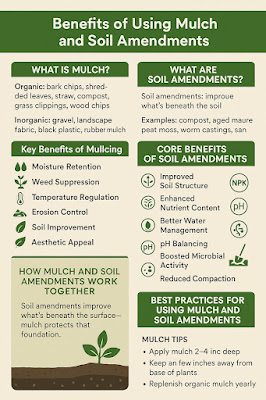Unlocking the power of mulch and soil amendments: A gardener’s guide to healthier soil and thriving plants
Healthy soil is the cornerstone of a successful garden, and two of the most powerful tools for improving soil health are mulch and soil amendments. Whether you're cultivating a vegetable patch, a flower bed, or a lush landscape, understanding how to use these elements effectively can drastically enhance plant performance, water retention, and soil vitality.
In this blog post, we’ll explore the full range of benefits that mulch and soil amendments offer and how you can incorporate them into your garden for long-lasting success.
What Is Mulch?
Mulch refers to any material—organic or inorganic—applied to the surface of the soil. Common types include:
- Organic: bark chips, shredded leaves, straw, compost, grass clippings, wood chips
- Inorganic: gravel, landscape fabric, black plastic, rubber mulch
Key Benefits of Mulching
- Moisture Retention: Reduces evaporation and keeps roots hydrated longer.
- Weed Suppression: Blocks light and prevents weed germination.
- Temperature Regulation: Insulates soil from temperature extremes.
- Erosion Control: Prevents topsoil from being washed away.
- Soil Improvement: Organic mulch enriches soil as it breaks down.
- Aesthetic Appeal: Creates a clean, finished look in garden beds.
What Are Soil Amendments?
Soil amendments are materials added into the soil to improve its physical or chemical properties. Examples include:
- Organic: compost, aged manure, peat moss, worm castings, biochar
- Inorganic: perlite, vermiculite, lime, gypsum, sand
Core Benefits of Soil Amendments
- Improved Soil Structure: Loosens clay and binds sandy soil.
- Enhanced Nutrient Content: Supplies essential plant nutrients.
- Better Water Management: Improves both moisture retention and drainage.
- pH Balancing: Corrects overly acidic or alkaline soils.
- Boosted Microbial Activity: Encourages beneficial soil life.
- Reduced Compaction: Increases air and water flow in soil.
How Mulch and Soil Amendments Work Together
When used together, mulch and soil amendments create a synergistic effect:
Soil amendments improve what’s beneath the surface. Mulch protects that foundation.
For example, before planting a vegetable garden, you can mix compost into the soil to boost fertility, then apply a layer of straw mulch to keep the soil moist and deter weeds. The result: healthier plants, less maintenance, and a more productive garden.
Best Practices for Using Mulch and Soil Amendments
Mulch Tips
- Apply mulch 2–4 inches deep for most garden beds.
- Keep mulch a few inches away from plant stems and trunks.
- Replenish organic mulch yearly as it decomposes.
Soil Amendment Tips
- Test soil pH and nutrient levels before adding amendments.
- Mix amendments into the soil—don't just layer them on top.
- Use compost regularly to build long-term soil fertility.
Conclusion: Invest in the Soil, Reap the Rewards
Both mulch and soil amendments are essential tools for any gardener looking to create a sustainable, low-maintenance, and high-performing garden. By protecting the soil surface and enhancing what's beneath it, you’re not just growing better plants—you’re building an ecosystem that will reward you season after season.
So next time you're out in the garden, think below the surface. Your plants—and the planet—will thank you.



